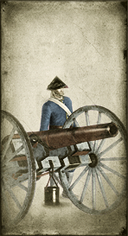
Basic Unit Statistics (can be modified by difficulty level, arts, skills, traits and retainers)
| Recruitment Cost | 1300 | |
| Upkeep Cost | 220 | |
| Melee Attack | 4 | 11% |
| Charge Bonus | 9 | 18% |
| Bonus vs Cavalry | 0 | 0% |
| Range | 550 | 84% |
| Accuracy | 30 | 30% |
| Reloading Skill | 50 | 50% |
| Ammunition | 20 | 25% |
| Melee Defence | 4 | 11% |
| Armour | 1 | 6% |
| Morale | 4 | 8% |
Strengths & Weaknesses
- Very long range and devastating explosive shells.
- Good accuracy and average reload rate.
- Weak in melee.
- Average morale.
Abilities
- Shrapnel Shot - This shell explodes mid-air, sending deadly metal fragments down upon targeted enemy units. Once activated, there will be a cooling-off period before the ability can be used again.
Description
An enemy dashed to smithereens is an enemy no more.
Armstrong guns are modern artillery pieces that can bombard the enemy at very long range with deadly and terrifying explosive shells. They are accurate and easy for their crews to reload but, like most artillery, these guns can be overrun in close combat. Their crews are not numerous, and are not trained to fight in hand-to-hand battle. Their morale, though, is good, as they take pride in using the some of the most modern and powerful artillery available. William Armstrong (1810-1900) was one of the engineering titans of Victorian Britain, and a prodigious inventor of mechanical devices. This talent gained him a Fellowship of the Royal Society, and made him an extremely rich man. His design for the built-up barrel of the breech-loading "Armstrong gun" was clever, making it extremely strong and accurate; there was even a rather modern "squeeze bore" design that narrowed the barrel very slightly at the muzzle. While the British war department continued to purchase muzzle loaders, Armstrong supplied both sides in the American Civil War. His other engineering interests were impressive. His home at Cragside in Northumberland had its own hydro-electric power plant. For decades his shipyards made cruisers and battleships for the Royal Navy and the Imperial Japanese Navy. Railway locomotives were another profitable enterprise.